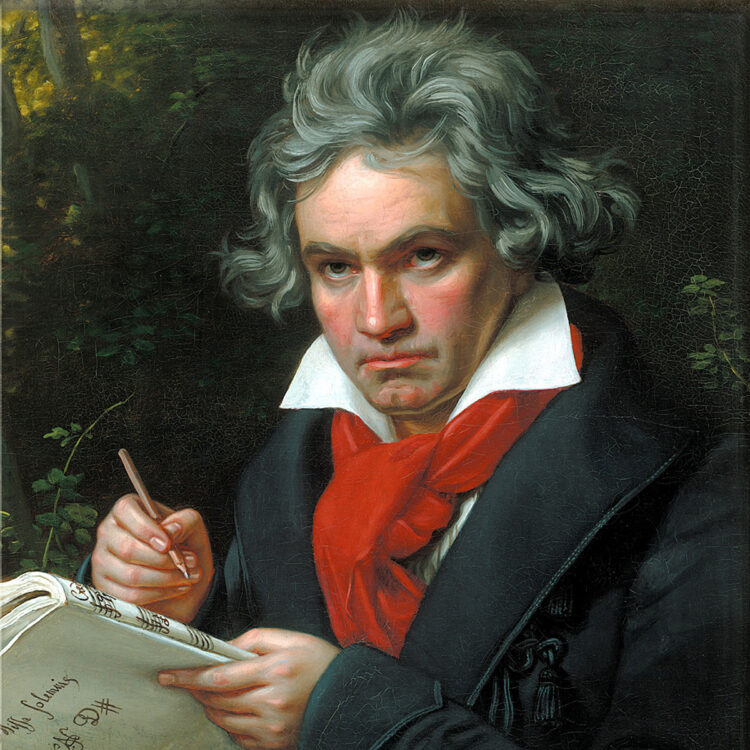Leonore Overture No. 2, Opus 72a
The overture known as Leonore No. 2 was actually the first of the three Leonore overtures to be composed. It was used at the first performance of Beethoven’s only opera (then called Leonore, but known in its revised, final form as Fidelio), which took place at the Theater an der Wien in Vienna on November 20, 1805.
Beethoven’s love affair with opera was long and not fairly requited. During the last four years of his life, he cherished a plan to collaborate with the poet Franz Grillparzer on a work based on the legend of the fairy Melusine, and the success of the one opera he actually wrote, the work that began as Leonore and came finally to be called Fidelio, came slowly and late, and at the cost of immense pain.
Leonore-Fidelio is a work of the type historians classify as a “rescue opera,” a genre distinctly popular in Beethoven’s day. A man called Florestan has been spirited away to prison by a right-wing politician by the name of Don Pizarro. Florestan’s whereabouts is not known, and his wife, Leonore, sets out to find him. To make her quest possible, she assumes male disguise and takes the name of “Fidelio.” She finds him. Meanwhile, Pizarro gets word of an impending inspection of the prison by a minister from the capital. The presence of the unjustly held Florestan is compromising to Pizarro, who determines simply to liquidate him. At the moment of crisis, Leonore reveals her identity and a trumpeter on the prison tower signals the sighting of the minister’s carriage.
Beethoven composed four overtures for Leonore-Fidelio, three of which we know as his Leonore overtures 1, 2, and 3. Ultimately Beethoven decided that a more traditional, less overwhelming opener was needed: for the final version of his opera he wrote what we know simply as the Fidelio Overture, which is about seven minutes long and serves to prepare the opera’s overall mood (and harmonic course). Leonore No. 2 introduced the opera in its original 1805 version; Leonore No. 3 opened the revised version of 1806; and Leonore No. 1 was composed for a projected 1807 Prague performance that did not take place (that overture not being heard until nearly a year after Beethoven’s death and not published until 1838). Leonore No. 1 is about nine minutes long and, like Leonores 2 and 3, uses music from the second act aria of Florestan, though in the context of otherwise different, and quite differently structured, musical material.
Leonores 2 and 3 run about fourteen minutes each, and are linked by similarities of both structure and overall musical material, which includes not only the music from Florestan’s aria but also, at the climax of each overture, the trumpet call that in Act II heralds the arrival of the minister of state, Don Fernando, whose presence ensures Florestan’s release from prison. Leonores 2 and 3 both tell the story of Fidelio using somewhat varied approaches to their shared musical materials. Or each traces, at least, a path from darkly troubled beginnings to an anticipation of the aria in which Florestan, chained, starved, deprived of light, recalls the happy springtime of his life; from there to music of fiery energy and action, interrupted by the trumpet signal (heard, as it is in the opera, from offstage); and finally to a symphony of victory. In Beethoven’s music, humanistic idealism transcends what many view as the claptrap and melodrama of the libretto.
Michael Steinberg/Marc Mandel
Marc Mandel, former Director of Program Publications for the Boston Symphony Orchestra, joined the staff of the BSO in November 1978 and managed the orchestra’s program book from 1979 until his retirement in July 2020.
Michael Steinberg was program annotator of the Boston Symphony Orchestra from 1976 to 1979, and after that of the San Francisco Symphony and New York Philharmonic. Oxford University Press has published three compilations of his program notes, devoted to symphonies, concertos, and the great works for chorus and orchestra.
The first Boston Symphony performances of all three Leonore overtures were given by Georg Henschel during the BSO’s inaugural season: Leonore No. 1 on February 18, 1882; No. 2 a week later, on February 25; and No. 3 a week after that, on March 4.

